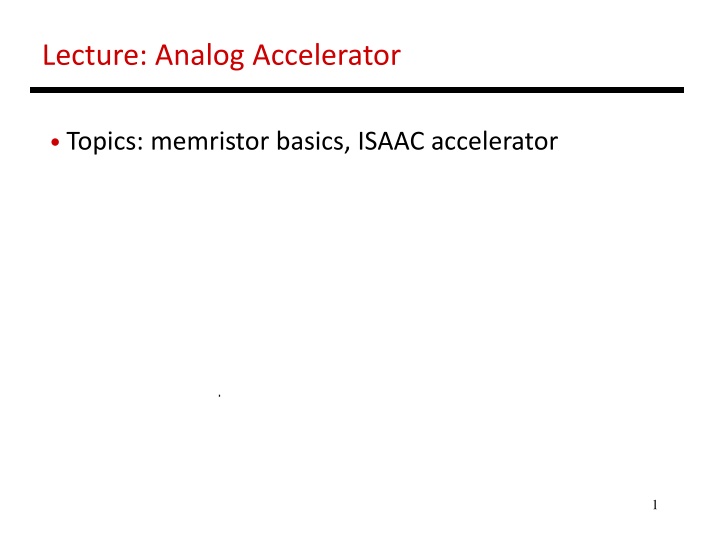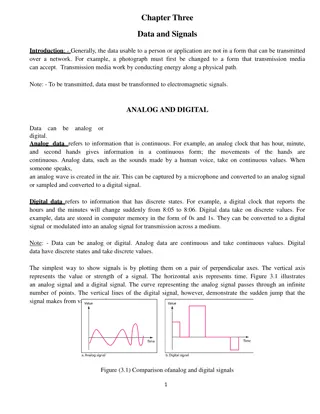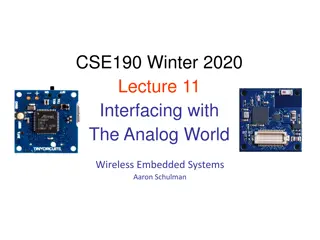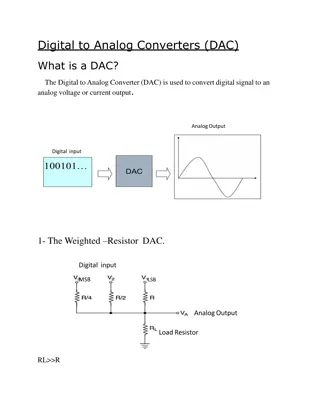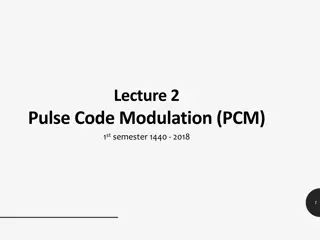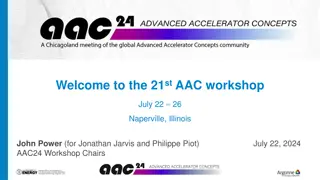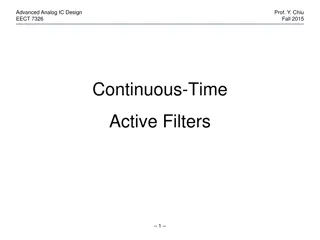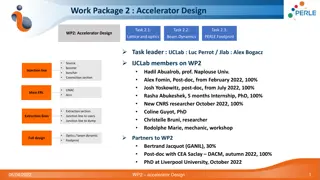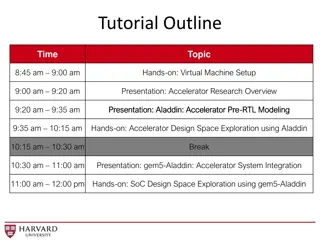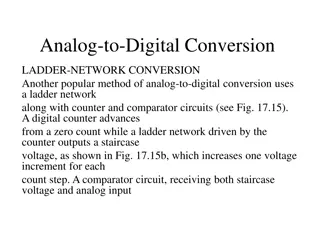Analog Accelerator: Memristor Basics and ISAAC Accelerator
Explore the world of analog acceleration with topics covering memristor basics and the ISAAC accelerator. From understanding noisy analog phenomena to leveraging wires as ALUs, delve into crossbars for vector-matrix multiplication and the challenges of high ADC/DAC area/energy. Discover solutions like spreading weights, aggregating partial sums, and weight encoding techniques for efficient analog computation.
Uploaded on Sep 19, 2024 | 4 Views
Download Presentation

Please find below an Image/Link to download the presentation.
The content on the website is provided AS IS for your information and personal use only. It may not be sold, licensed, or shared on other websites without obtaining consent from the author.If you encounter any issues during the download, it is possible that the publisher has removed the file from their server.
You are allowed to download the files provided on this website for personal or commercial use, subject to the condition that they are used lawfully. All files are the property of their respective owners.
The content on the website is provided AS IS for your information and personal use only. It may not be sold, licensed, or shared on other websites without obtaining consent from the author.
E N D
Presentation Transcript
Lecture: Analog Accelerator Topics: memristor basics, ISAAC accelerator 1
Analog Acceleration Many electronic phenomena correspond to multiplication and addition Analog phenomena are also noisy; perhaps, this is not an issue when dealing with neural networks 2
Wires as ALUs V1 G1 I1 =V1.G1 V2 G2 I2 =V2.G2 I = I1 + I2 = V1.G1 + V2.G2 3
Crossbar for Vector-Matrix Multiplication DAC DAC DAC DAC S&H S&H S&H S&H 4 ADC
Physical View Wordline Memristor cell Bitline Driver circuits in silicon substrate Physical view of a memristor crossbar array 5
Challenge High ADC/DAC area/energy You could stay in analog forever, but then you d need expensive analog buffering and you d introduce significant noise that accumulates across network layers Unfortunately, some ADC overheads increase exponentially with resolution Resolution increases with computational density 6
1. Input One Bit at a Time Need a trivial DAC Must perform multiplication over 16 iterations Results are aggregated with shift-and-adds 7
2. Spread the Weights A single weight is spread across 8 2-bit cells in a row The outputs of 8 columns have to be shifted and added Low bits per cell is good for precision and for ADC efficiency 8
3. Few Rows Per Crossbar Requires us to use many small crossbars A neuron with many inputs is spread across multiple xbars Must aggregate partial sums from many xbars 9
4. Weight Encoding If the weights are large, store their complements Reduces ADC resolution by 1 bit Inputs are provided in 2 s complement form The MSb represents -215 -- need a shift-and-subtract Irrelevant if we are using ReLU Weights are stored with a bias: a bias of 215 allows unsigned integers to represent weights between -215 and 215 - 1 10
Analog Accelerator Challenge High ADC/DAC area/energy 1. 1-bit input at a time (small v) 2. 2-bit cells (small w) 3. Few rows per array (small R) 4. Encoding tricks to produce small numbers Spread the computation across a single xbar, across multiple xbars, and across time to reduce ADC size 11
ISAAC Pipeline (a) Example of different layers in action at the same time B B B B Layer 2 Layer 4 Layer 5 Layer 3 Layer 1 (b) Example of one operation in layer i flowing through its pipeline Cyc 1 2 3 4 17 18 19 20 21 22 Xbar 16 Xbar 1 Xbar 2 Xbar 3 eDRAM Rd + IR S+A OR wr S+A OR wr ADC eDRAM Wr Tile IMA IMA IMA IMA IMA IMA Tile Tile Tile 13
Pipeline Variants Most digital accelerators use temporal pipelines all units work on 1 layer, then all work on the next layer, etc. Good for low latency and cache locality A spatial pipeline would give nearly the same throughput, but higher latency per inference Analog accelerators use spatial pipelines parts of the chip are hard-coded to execute specific layers Required by design since weight updates are slow Latency impact is small (no batching required and for the most part, all layers work on the same image) 14
The ISAAC Pipeline Pipelining within an IMA/tile/layer Pipelining across layers Network is mapped to avoid hazards; balanced replication where possible to avoid storage/compute under-utilization Design space exploration to identify the best use of chip real estate 16
Comparison to DaDianNao 7.5X higher computational density 14.8X higher throughput on CNN benchmarks 5.5X lower energy The chip has a 3X higher power density 20
Other Analog Innovations AN codes for reliability (Feinberg et al., HPCA 18) Crossbars applied to scientific computing (Feinberg et al., ISCA 18) More efficient ADCs (e.g., PipeLayer, HPCA 17) Memristor-aided logic (Kvatinsky et al., IEEE Trans. On Circuits and Systems, 2014) activate two rows and ground a third row to perform a NOR operation within the crossbar 22
References ISAAC: A Convolutional Neural Network Accelerator with In-Situ Analog Arithmetic in Crossbars , A. Shafiee et al., Proceedings of ISCA, 2016 23
